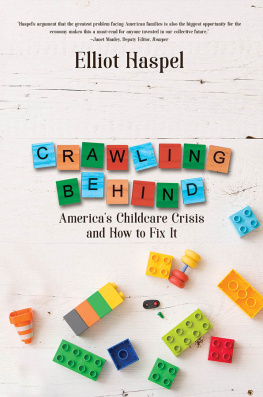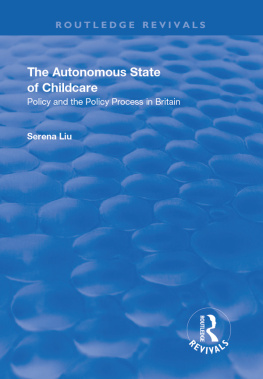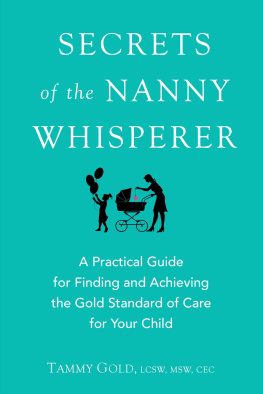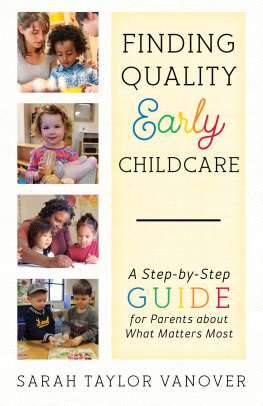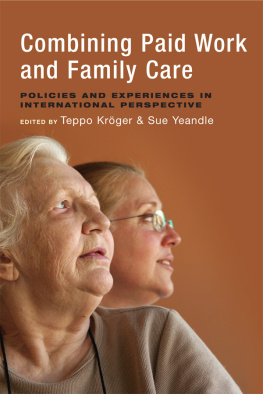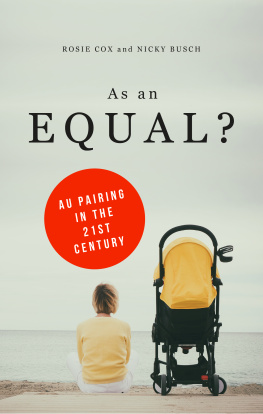NANNIES, MIGRATION AND
EARLY CHILDHOOD EDUCATION
AND CARE
An international comparison of
in-home childcare policy and
practice
Elizabeth Adamson
First published in Great Britain in 2017 by
Policy Press University of Bristol 1-9 Old Park Hill Bristol BS2 8BB UK Tel +44 (0)117 954 5940 e-mail
North American office: Policy Press c/o The University of Chicago Press 1427 East 60th Street Chicago, IL 60637, USA t: +1 773 702 7700 f: +1 773-702-9756 e:
Policy Press 2017
British Library Cataloguing in Publication Data
A catalogue record for this book is available from the British Library
Library of Congress Cataloging-in-Publication Data
A catalog record for this book has been requested
ISBN 978-1-4473-3014-1 hardcover
ISBN 978-1-4473-3380-7 ePub
ISBN 978-1-4473-3381-4 Mobi
ISBN 978-1-4473-3015-8 ePdf
The right of Elizabeth Adamson to be identified as author of this work has been asserted by her in accordance with the Copyright, Designs and Patents Act 1988.
All rights reserved: no part of this publication may be reproduced, stored in a retrieval system, or transmitted in any form or by any means, electronic, mechanical, photocopying, recording, or otherwise without the prior permission of Policy Press.
The statements and opinions contained within this publication are solely those of the author and not of the University of Bristol or Policy Press. The University of Bristol and Policy Press disclaim responsibility for any injury to persons or property resulting from any material published in this publication.
Policy Press works to counter discrimination on grounds of gender, race, disability, age and sexuality.
Cover design by Policy Press
Front cover image: istock
Readers Guide
This book has been optimised for PDA.
Tables may have been presented to accommodate this devices limitations.
Image presentation is limited by this devices limitations
Contents
List of tables
Acknowledgements
I would like to acknowledge the various individuals that made this book possible. First, thank you to Deb Brennan and Fiona Williams for instilling the idea, and for your mentorship and inspiration in helping me to achieve my goals. To my friends and colleagues at the Social Policy Research Centre, thank you for your support and encouragement to keep writing.
To Mom, Dad, Heather and Geoff, thank you for your constant love and friendship. Whether in person or over the phone, you are always there to help celebrate the good times and work through the challenges. To Pete, I cannot thank you enough for always being by my side even from the other side of the country. You continue to challenge and support me to reach my goals, and provide endless love and laughter along the way.
To all the research participants, thank you for sharing your time and knowledge with me. The rich information you provided has contributed to an understanding of the dynamics and complexities of childcare, nannies and early education that extends far beyond the scope of this book.
Last but not least, I would like to acknowledge the support of the Australian Research Council and the Faculty of Arts and Social Sciences and Graduate Research School at the University of New South Wales for making earlier stages of this research possible.
Elizabeth Adamson, May 2016
Introduction
In-home childcare, commonly referred to as care by nannies and au pairs, is not new.These forms of childcare and domestic care work have existed for centuries in some countries. What is worthy of attention is the fact that these forms of childcare until recently remained firmly in the informal and private care domains. The restructuring of welfare state services primarily through marketisation has changed the nature of such forms of childcare. Through childcare funding and regulation, forms of in-home childcare that previously were situated in the private and informal sphere are being repositioned across the public and formal sphere. At the same time, in some countries, migration policy facilitates in-home childcare. Just as other forms of childcare and early education (such as kindergarten, preschool, centre-based services and family day care) have developed in distinct ways across countries, so too have forms of in-home childcare.
The childcare and early education field has gained visibility and momentum on the policy agenda as scholars and international organisations have demonstrated the various benefits of quality early learning and childcare for young children and their families. Governments and international organisations have, albeit to different extents, embraced the term early childhood education and care (ECEC) to promote the dual focus of childrens education and care on policy agendas. Increased public and private investment has been driven by demographic changes, such as increases in womens workforce participation, and also by evidence that demonstrate the benefits of high-quality ECEC for childrens development and wellbeing. ECEC does not, however, always address the needs of mothers and children at the same time. Some ECEC programmes are designed specifically to meet the needs of children through high-quality early learning programmes, notably part-day preschool or kindergarten for children in the year before school. Others, such as full-day care in centre- and home-based settings are typically designed to also facilitate parents employment. Childrens participation in these types of regulated, centre-based ECEC has increased in most developed (and developing countries) since the 1960s, including in the three liberal English-speaking countries that are the focus of this book: Australia, the United Kingdom
Despite the trend towards regulated and centre-based ECEC, many parents still rely on more informal home-based care by grandparents, other relatives and friends. In addition to reliance on these informal care arrangements, some families are increasingly seeking flexible, in-home childcare provided by non-relatives such as nannies as their primary or supplementary choice of care. The need for flexible in-home forms of ECEC is associated with longer work hours and non-standard forms of employment. Some governments across the developed world are redesigning ECEC funding and regulatory mechanisms to support these forms of care (DfES, 2002; Morel, 2007; Sipil et al, 2010; Fagnani and Math, 2011; Australian Government, 2015). Such support can appear perplexing, given the strong government rhetoric in some countries about the need for increased social investment through expenditure on high-quality, universal ECEC services, generally assumed to be centre-based services (OECD, 2006, 2012).
ECEC has moved from a peripheral to a central place on governments agendas and, at the same time, there have been changes in the way governments fund and deliver services. There have been shifts in emphasis from care to education, from community-based to market-provided services and from supply-side to demand-side funding. Therefore, while many governments can be applauded for increasing spending on ECEC and children more broadly, attention should be given to the design of childcare and how welfare state restructuring is shaping the purpose and outcomes of ECEC services. There are active debates about the optimal approach to ECEC provision within international organisations, across regimes, and within countries and regions. While many countries across the globe have adopted the term early childhood education and care to denote a unified approach to care and education for young children, the extent of governments involvement and responsibility for funding, delivering and regulating services remains varied (OECD, 2006). And, in many cases traditional spheres of care and education remain divided along political, ideological and cultural lines (Jenson and Sineau, 2001; Kremer, 2007).








